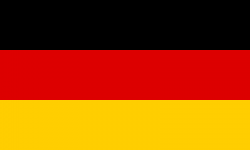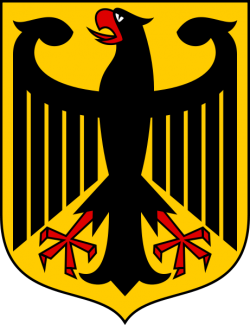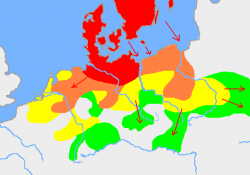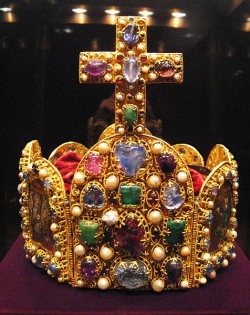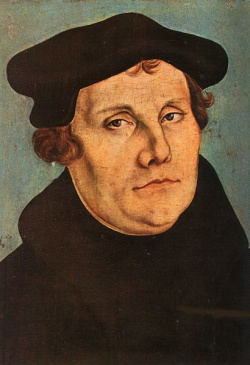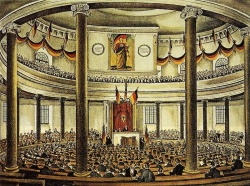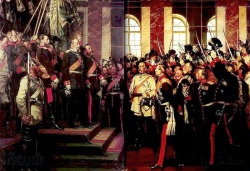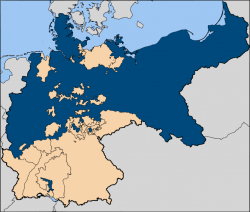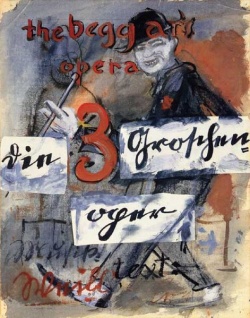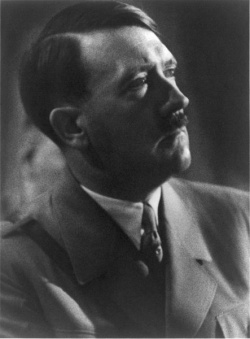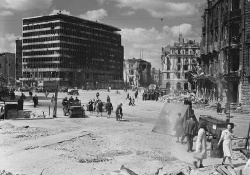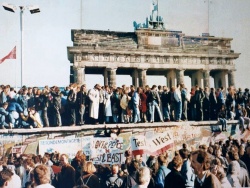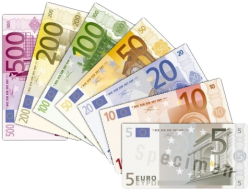Germany
From Textus Receptus
Germany (pronounced /ˈdʒɜrməni/), officially the Federal Republic of Germany (German: Bundesrepublik Deutschland, pronounced [ˈbʊndəsʁepuˌbliːk ˈdɔʏtʃlant]),[4] is a country in Central Europe. It is bordered to the north by the North Sea, Denmark, and the Baltic Sea; to the east by Poland and the Czech Republic; to the south by Austria and Switzerland; and to the west by France, Luxembourg, Belgium, and the Netherlands. The territory of Germany covers 357,021 square kilometers (137,847 sq mi) and is influenced by a temperate seasonal climate. With 82 million inhabitants, it accounts for the largest population among the member states of the European Union and is home to the third-largest number of international migrants worldwide.[5]
A region named Germania, inhabited by several Germanic peoples, has been known and documented before AD 100. Beginning in the 10th century, German territories formed a central part of the Holy Roman Empire, which lasted until 1806. During the 16th century, northern Germany became the centre of the Protestant Reformation. As a modern nation-state, the country was first unified amidst the Franco-Prussian War in 1871. In 1949, after World War II, Germany was divided into two separate states—East Germany and West Germany—along the lines of Allied occupation.[[6] Germany was reunified in 1990. West Germany was a founding member of the European Community (EC) in 1957, which became the European Union in 1993. It is part of the Schengen zone and adopted the European currency, the euro, in 1999.
Germany is a federal parliamentary republic of sixteen states (Länder). The capital and largest city is Berlin. Germany is a member of the United Nations, NATO, G8, G20, OECD, and the WTO. It is a major power with the world's fourth largest economy by nominal GDP and the fifth largest in purchasing power parity. It is the second largest exporter and second largest importer of goods. In absolute terms, Germany allocates the second biggest annual budget of development aid in the world,[7] while its military expenditure ranked sixth.[8] The country has developed a high standard of living and established a comprehensive system of social security. It holds a key position in European affairs and maintains a multitude of close partnerships on a global level.[9] Germany is recognised as a scientific and technological leader in several fields.[10]
History
The English word "Germany" derives from the Latin word Germania. The name "Germania" came into use after Julius Caesar adopted it from a Gallic term for the peoples east of the Rhine that probably meant. [11][12]
Germanic tribes
The ethnogenesis of the Germanic tribes is assumed to have occurred during the Nordic Bronze Age, or at the latest, during the Pre-Roman Iron Age. From southern Scandinavia and northern Germany, the tribes began expanding south, east and west in the 1st century BC, coming into contact with the Celtic tribes of Gaul as well as Iranian, Baltic, and Slavic tribes in Eastern Europe. Little is known about early Germanic history, except through their recorded interactions with the Roman Empire, etymological research and archaeological finds.[13]
Under Augustus, the Roman General Publius Quinctilius Varus began to invade Germania (a term used by the Romans to define a territory running roughly from the Rhine to the Ural Mountains), and it was in this period that the Germanic tribes became familiar with Roman tactics of warfare while maintaining their tribal identity. In AD 9, three Roman legions led by Varus were defeated by the Cheruscan leader Arminius in the Battle of the Teutoburg Forest. Modern Germany, as far as the Rhine and the Danube, thus remained outside the Roman Empire. By AD 100, the time of Tacitus' Germania, Germanic tribes settled along the Rhine and the Danube (the Limes Germanicus) , occupying most of the area of modern Germany; Austria, southern Bavaria and the western Rhineland, however, were Roman provinces. The 3rd century saw the emergence of a number of large West Germanic tribes: Alamanni, Franks, Chatti, Saxons, Frisians, Sicambri, and Thuringii. Around 260, the Germanic peoples broke through the Limes and the Danube frontier into Roman-controlled lands.[14]
Holy Roman Empire (962–1806)
On 25 December 800, Charlemagne founded the Carolingian Empire, which was divided in 843. The medieval empire resulted from the eastern portion of this division and existed in varying forms from 962 until 1806. Its territory stretched from the Eider River in the north to the Mediterranean coast in the south. Often referred to as the Holy Roman Empire (or the Old Empire), it was officially called the Sacrum Romanum Imperium Nationis Germanicæ (Holy Roman Empire of the German Nation) starting in 1448, to adjust the title to its then reduced territory.
Under the reign of the Ottonian emperors (919–1024), the duchies of Lorraine, Saxony, Franconia, Swabia, Thuringia, and Bavaria were consolidated, and the German king was crowned Holy Roman Emperor of these regions in 962. Under the reign of the Salian emperors (1024–1125), the Holy Roman Empire absorbed northern Italy and Burgundy, although the emperors lost power through the Investiture Controversy. Under the Hohenstaufen emperors (1138–1254), the German princes increased their influence further south and east into territories inhabited by Slavs, preceding German settlement in these areas and further east (Ostsiedlung). Northern German towns grew prosperous as members of the Hanseatic League. Starting with the Great Famine in 1315, then the Black Death of 1348–50, the population of Germany plummeted.[15]
The edict of the Golden Bull in 1356 provided the basic constitution of the empire that lasted until its dissolution. It codified the election of the emperor by seven prince-electors who ruled some of the most powerful principalities and archbishoprics. Beginning in the 15th century, the emperors were elected nearly exclusively from the Habsburg dynasty of Austria.
The monk Martin Luther publicised his 95 Theses in 1517, challenging practices of the Roman Catholic Church, initiating the Protestant Reformation. A separate Lutheran church became the official religion in many German states after 1530. Religious conflict led to the Thirty Years' War (1618–1648), which devastated German lands.[16] The population of the German states was reduced by about 30%.[17] The Peace of Westphalia (1648) ended religious warfare among the German states, but the empire was de facto divided into numerous independent principalities. From 1740 onwards, the dualism between the Austrian Habsburg Monarchy and the Kingdom of Prussia dominated German history. In 1806, the Imperium was overrun and dissolved as a result of the Napoleonic Wars.[18]
Restoration and revolution (1814–1871)
Following the fall of Napoleon Bonaparte, the Congress of Vienna convened in 1814 and founded the German Confederation (Deutscher Bund), a loose league of 39 sovereign states. Disagreement with restoration politics partly led to the rise of liberal movements, demanding unity and freedom. These, however, were followed by new measures of repression on the part of the Austrian statesman Metternich. The Zollverein, a tariff union, profoundly furthered economic unity in the German states. During this era many Germans had been stirred by the ideals of the French Revolution, and nationalism became a more significant force, especially among young intellectuals. For the first time, the colours of black, red and gold were chosen to represent the movement, which later became the national colours.<sup>[19]</sup>
In light of a series of revolutionary movements in Europe, which successfully established a republic in France, intellectuals and commoners started the Revolutions of 1848 in the German states. The monarchs initially yielded to the revolutionaries' liberal demands. King Frederick William IV of Prussia was offered the title of Emperor, but with a loss of power; he rejected the crown and the proposed constitution, leading to a temporary setback for the movement. Conflict between King William I of Prussia and the increasingly liberal parliament erupted over military reforms in 1862, and the king appointed Otto von Bismarck the new Prime Minister of Prussia. Bismarck successfully waged war on Denmark in 1864. Prussian victory in the Austro-Prussian War of 1866 enabled him to create the North German Federation (Norddeutscher Bund) and to exclude Austria, formerly the leading German state, from the affairs of the remaining German states.
German Empire (1871–1918)
The state known as Germany was unified as a modern nation-state in 1871, when the German Empire was forged, with the Kingdom of Prussia as its largest constituent. After the French defeat in the Franco-Prussian War, the German Empire was proclaimed in Versailles on 18 January 1871. The Hohenzollern dynasty of Prussia ruled the new empire, whose capital was Berlin. The empire was a unification of all the scattered parts of Germany except Austria (Kleindeutschland, or "Lesser Germany"). Beginning in 1884, Germany began establishing several colonies outside of Europe.
In the Gründerzeit period following the unification of Germany, Emperor William I's foreign policy secured Germany's position as a great nation by forging alliances, isolating France by diplomatic means, and avoiding war. Under William II, however, Germany, like other European powers, took an imperialistic course leading to friction with neighbouring countries. Most alliances in which Germany had been previously involved were not renewed, and new alliances excluded the country. Specifically, France established new relationships by signing the Entente Cordiale with the United Kingdom and securing ties with the Russian Empire. Aside from its contacts with Austria-Hungary, Germany became increasingly isolated.
Germany's imperialism reached outside of its own country and joined many other powers in Europe in claiming their share of Africa. The Berlin Conference divided Africa between the European powers. Germany owned several pieces of land in Africa including German East Africa, South-West Africa, Togo, and Cameroon. The Scramble for Africa caused tension between the great powers that may have contributed to the conditions that led to World War I.
The assassination of Austria's crown prince on 28 June 1914 triggered World War I. Germany, as part of the unsuccessful Central Powers, suffered defeat against the Allied Powers in one of the bloodiest conflicts of all time. An estimated two million German soldiers died in World War I.<sup>[20]</sup> The German Revolution broke out in November 1918, and Emperor William II and all German ruling princes abdicated. An armistice putting an end to the war was signed on 11 November and Germany was forced to sign the Treaty of Versailles in June 1919. Its negotiation, contrary to traditional post-war diplomacy, excluded the defeated Central Powers. The treaty was perceived in Germany as a humiliating continuation of the war by other means and its harshness is often cited as having facilitated the later rise of Nazism in the country.<sup>[21]</sup>
Weimar Republic (1919–1933)
At the beginning of the German Revolution, Germany was declared a republic and the monarchy collapsed. However, the struggle for power continued, with radical-left communists seizing power in Bavaria, but failing to take control of all of Germany. The revolution came to an end in August 1919, when the Weimar Republic was formally established. The Weimar Constitution came into effect with its signing by President Friedrich Ebert on 11 August 1919.
Suffering from the Great Depression, the harsh peace conditions dictated by the Treaty of Versailles, and a long succession of more or less unstable governments, the people of Germany increasingly lacked identification with their political system and the "Establishment Parties" in their parliamentary democracy. This was exacerbated by a widespread right-wing (monarchist, völkisch, and Nazi) Dolchstoßlegende, which promoted the view that Germany had lost World War I because of the efforts and influence of those who wanted to overthrow the government. The top brass of the Weimar government was accused of betraying the German Nation by signing the Versailles Treaty, while the radical left-wing communists, such as the Spartacist League, had wanted a revolution to abolish "capitalist rule" in favour of a Räterepublik, and were also targeted.
Nevertheless, discontentment with the new Weimar government helped fuel the growth of the German Communist Party. Many conservatives were drawn towards the reactionary/revolutionary right, particularly the National Socialist German Workers Party—the Nazi Party. By 1932, these two parties controlled the majority of parliament (296 total parliamentary seats by July 1932). After a series of unsuccessful cabinets, President Paul von Hindenburg made a crucial decision: on 30 January 1933, seeing little alternative and pushed by right-wing advisors, von Hindenburg appointed Adolf Hitler as Chancellor of Germany, honoring Hitler's request.
Third Reich (1933–1945)
On 27 February 1933, the Reichstag went up in flames. Afterwards an emergency decree was made and some basic democratic rights were quickly abrogated. An Enabling Act gave the Hitler-led government full legislative power. Only the Social Democratic Party of Germany voted against the measure, while the Communists, who were thought to be behind the fire, were not able to present opposition due to the Reichstag Fire Decree.<sup>[22]</sup> A centralised totalitarian state was established by a series of moves and decrees making Germany a single-party state. Industry was revitalised, with a focus on military rearmament.<sup>[23]</sup> In 1936, Germany reacquired control of the Rhineland, the first of several expansionist moves to establish Greater Germany.
In 1939, growing tensions from nationalism, militarism, territorial issues, and a pact promising support from the Soviet Union led Germany to launch a blitzkrieg against Poland, which was divided between Germany and the Soviet Union which attacked the country from the east. This incident was followed by declarations of war from Britain and France against Germany, but not against the Soviet Union. This marked the beginning of World War II in Europe. As the war continued, Germany and its allies quickly gained direct or indirect control of the majority of Europe.
On 22 June 1941, Germany broke the pact with the Soviets and invaded the Soviet Union. The same year, Japan attacked the American base at Pearl Harbor, and Germany declared war on the United States as a consequence of its alliance with Japan. Although the German army advanced into the Soviet Union quite rapidly, the Battle of Stalingrad marked a major turning point in the war. Subsequently, the German army started to retreat on the Eastern front. In September of 1943, Germany's ally Italy surrendered, and German forces were forced to defend an additional front in Italy. D-Day marked another major turning point in the war, opening up a Western front; the Allied forces landed on the beaches of Normandy and made advances towards German territory. Germany's defeat soon followed. On 8 May 1945, the German armed forces surrendered after the Red Army occupied Berlin. Approximately seven million German soldiers and civilians—including ethnic Germans from Eastern Europe—died during World War II.<sup>[24]</sup>
In what later became known as The Holocaust, the Third Reich regime enacted governmental policies directly subjugating many dissidents and minorities. About seventeen million people were murdered during the Holocaust, including six million Jews and sizable number of Gypsies, Poles and other Slavs, including Soviet POWs, the mentally ill, homosexuals, and members of the political opposition.<sup>[25]</sup> World War II and the Nazi genocide were responsible for more than 40 million dead in Europe.<sup>[26]</sup> The Nuremberg trials of Nazi war criminals were held after World War II.<sup>[27]</sup>
Division and reunification (1945–1990)
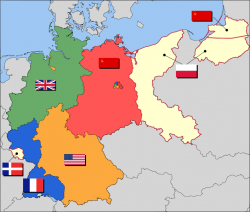
The war resulted in the death of nearly ten million German soldiers and civilians;[citation needed] large territorial losses; the expulsion of about 15 million Germans from the eastern areas of Germany and other countries; rape of up to two million German women; and the destruction of multiple major cities. The remaining national territory and Berlin were partitioned by the Allies into four military occupation zones.
The western sectors, controlled by France, the United Kingdom, and the United States, were merged on 23 May 1949, to form the Federal Republic of Germany (Bundesrepublik Deutschland); on 7 October 1949, the Soviet Zone became the German Democratic Republic (Deutsche Demokratische Republik, or DDR). They were, mainly outside Germany, informally known as "West Germany" and "East Germany" (in West Germany, East Germany referred to the areas east of the GDR, while the GDR was often referred to as Middle Germany), and the two parts of Berlin as "West Berlin" and "East Berlin". East Germany selected East Berlin as its capital, while West Germany chose Bonn. However, West Germany declared the status of its capital Bonn as provisional, in order to emphasise its stance that the two-state solution was an artificial status quo that was to be overcome one day.<sup>[28]</sup>
West Germany, established as a federal parliamentary republic with a "social market economy", was allied with the United States, the UK and France. The country came to enjoy prolonged economic growth beginning in the early 1950s (Wirtschaftswunder). West Germany joined NATO in 1955 and was a founding member of the European Economic Community in 1957.
East Germany was an Eastern bloc state under political and military control by the USSR via the latter's occupation forces and the Warsaw Treaty. While claiming to be a democracy, political power was solely executed by leading members (Politburo) of the communist-controlled SED (Socialist Unity Party of Germany). Their power was ensured by the Stasi, a secret service of immense size, and a variety of SED suborganizations controlling every aspect of society. In return, the basic needs of the population were satisfied at low cost by the state. A Soviet-style command economy was set up; later, the GDR became a Comecon state. While East German propaganda was based on the benefits of the GDR's social programs and the alleged constant threat of a West German invasion, many of her citizens looked to the West for political freedoms and economic prosperity.<sup>[29]</sup> The Berlin Wall, built in 1961 to stop East Germans from escaping to West Germany, became a symbol of the Cold War.
Tensions between East and West Germany were somewhat reduced in the early 1970s by Chancellor Willy Brandt's Ostpolitik, which included the de facto acceptance of Germany's territorial losses in World War II.
In the summer of 1989, Hungary decided (May 2) to dismantle the Iron Curtain and open the borders (August 23), causing an exodus of thousands of East Germans (September 11) going to West Germany via Hungary. The effects of the Hungarian events had devastating effects on the GDR, with mass demonstrations. The East German authorities unexpectedly eased the border restrictions in November, allowing East German citizens to travel to the West. Originally intended as a pressure valve to retain East Germany as a state, the opening of the border actually led to an acceleration of the Wende reform process in East Germany, which finally concluded with the Two Plus Four Treaty a year later on 12 September 1990, under which the four occupying powers renounced their rights under the Instrument of Surrender, and Germany regained full sovereignty. This permitted German reunification on 3 October 1990, with the accession of the five re-established states in the former GDR (New states or "neue Länder").
Berlin Republic and EU integration (1990–)
Based on the Bonn-Berlin Act, adopted by the parliament on 10 March 1994, Berlin once again became the capital of the reunified Germany, while Bonn obtained the unique status of a Bundesstadt (federal city) retaining some federal ministries.<sup>[30]</sup><sup>[31]</sup> The relocation of the government was completed in 1999.
Since reunification, Germany has taken a more active role in the European Union and NATO. Germany sent a peacekeeping force to secure stability in the Balkans and sent a force of German troops to Afghanistan as part of a NATO effort to provide security in that country after the ousting of the Taliban.<sup>[32]</sup> These deployments were controversial, since after the war, Germany was bound by domestic law only to deploy troops for defence roles. Deployments to foreign territories were understood not to be covered by the defence provision; however, the parliamentary vote on the issue effectively legalised the participation in a peacekeeping context.
For more articles, see the External Link below.
References
- 1. "CIA Factbook". https://www.cia.gov/library/publications/the-world-factbook/geos/gm.html. Retrieved 2009-08-02.
- 2. "Germany". International Monetary Fund. http://www.imf.org/external/pubs/ft/weo/2009/02/weodata/weorept.aspx?sy=2006&ey=2009&scsm=1&ssd=1&sort=country&ds=.&br=1&c=134&s=NGDPD%2CNGDPDPC%2CPPPGDP%2CPPPPC%2CLP&grp=0&a=&pr.x=64&pr.y=4. Retrieved 2009-10-01.
- 3. Human Development Report 2009. The United Nations. Retrieved 5 October 2009.
- 4. Max Mangold (ed.), ed (1995) (in German). Duden, Aussprachewörterbuch (Duden Pronunciation Dictionary) (6th ed.). Mannheim: Dudenverlag (Bibliographisches Institut & F.A. Brockhaus AG. pp. 271, 53f. ISBN 3-411-04066-1.
- 5. "Germany: Inflow of foreign population by country of nationality, 1994 to 2003". Migrationinformation.org. http://www.migrationinformation.org/datahub/countrydata/country.cfm. Retrieved 2010-01-04.
- 6. Federal Constitutional Court of Germany (2 BvF 1/73; BVerfGE 36, 1): The German Reich as the German state is identically the very same to the Federal Republic of Germany [because it exists as a nation-state and international legal personality (public international law) since 1871]. In 1949, at East – West Germany division there was no foundation of a new West German state and no successor of the German Reich, instead of that a part of Germany was reorganised.
- 7. Germany world's second biggest aid donor after US TopNews, India. Retrieved 2008-04-10.
- 8. "The fifteen major spenders in 2006" (PDF). Recent trends in military expenditure. Stockholm International Peace Research Institute. 2007. Archived from the original on 2007-08-14. http://web.archive.org/web/20070814224502/http://www.sipri.org/contents/milap/milex/mex_major_spenders.pdf/download. Retrieved 2007-08-23.
- 9. The leader of Europe? Answers an ocean apart International Herald Tribune. April 4, 2008. Retrieved 2008-04-04.
- 10. Confidently into the Future with Reliable Technology www.innovations-report.de. May 7, 2008. Retrieved 2008-04-04.
- 11. Schulze, Hagen. Germany: A New History. Cambridge, MA: Harvard University Press. p. 4.
- 12. "German", The Concise Oxford Dictionary of English Etymology. Ed. T. F. Hoad. Oxford: Oxford University Press, 1996. Oxford Reference Online. Oxford University Press. Retrieved March 4, 2008.
- 13. Jill N. Claster: Medieval Experience: 300–1400. New York University Press 1982, p. 35. ISBN 0814713815.
- 14. The Cambridge Ancient History, vol. 12, p. 442. ISBN 0521301998.
- 15. The Great Famine (1315–1317) and the Black Death (1346–1351). Lynn Harry Nelson. The University of Kansas.
- 16. The Thirty-Years-War, Gerhard Rempel, Western New England College.
- 17. The Thirty Years War (1618–48), Alan McFarlane, The Savage Wars of Peace: England, Japan and the Malthusian Trap (2003)
- 18. Fulbrook, Mary: A Concise History of Germany, Cambridge University Press 1991, p. 97. ISBN 0521540712
- 19. Martin, Norman. German Confederation 1815–1866 (Germany) Flags of the World. October 5, 2000. Retrieved 2006-12-07.
- 20. Last German World War I Veteran Believed to Have Died. Spiegel Online. January 22, 2008.
- 21. Stephen J. Lee: Europe, 1890–1945. Routledge 2003, p. 131. ISBN 0415254558.
- 22. Deutsches Historisches Museum. "Das Ermächtigungsgesetz 1933" (in German). Deutsches Historisches Museum. http://www.dhm.de/lemo/html/nazi/innenpolitik/ermaechtigungsgesetz/index.html. Retrieved 2008-09-12. "An der Abstimmung nicht teilnehmen konnten die 81 Abgeordneten der Kommunistischen Partei Deutschlands (KPD). Ihre Mandate waren auf Basis der Reichstagsbrandverordnung bereits am 8. März 1933 annulliert worden."
Roderick Stackelberg, Hitler's Germany: origins, interpretations, legacies. Routledge 1999, p. 103. ISBN 0415201144. Scheck, Raffael. Establishing a Dictatorship: The Stabilization of Nazi Power Colby College. Retrieved 2006-07-12.
- 23. Deutsches Historisches Museum. "Industrie und Wirtschaft" (in German). Deutsches Historisches Museum. http://www.dhm.de/lemo/html/nazi/wirtschaft/index.html. Retrieved 2008-09-12. "Der Vierjahresplan sollte ab 1936 die wirtschaftliche Kriegsfähigkeit Deutschlands herbeiführen. . . .Bereits im Februar 1933 erklärte Hitler, dass alle öffentlichen Maßnahmen zur Arbeitsbeschaffung zugleich der "Wehrhaftmachung" zu dienen hätten und den Interessen des Staates untergeordnet seien. . . ."
- 24. Steinberg, Heinz Günter. Die Bevölkerungsentwicklung in Deutschland im Zweiten Weltkrieg : mit einem Überblick über die Entwicklung von 1945 bis 1990. Bonn 1991. Also see World War II casualties
- 25. Niewyk, Donald L. and Nicosia, Francis R. The Columbia Guide to the Holocaust, Columbia University Press, 2000, pp. 45-52.
- 26. "Leaders mourn Soviet wartime dead". BBC News. May 9, 2005.
- 27. "Nuremberg: Nazis On Trial". Professor Richard Overy. BBC - History.
- 28. Wise, Michael Z. (1998). "Bonn, Capital of Self-Effacement". Capital dilemma: Germany's search for a new architecture of democracy. Princeton Architectural Press, 1998. p. 23. ISBN 9781568981345.
- 29. Colchester, Nico. D-mark day dawns Financial Times. January 1, 2001. Retrieved 2006-12-07.
- 30. (German) Landtag einstimmig gegen Komplettumzug WDR; 14 September 2006.
- 31. (German) Deutschlands heimliche Hauptstadt Landtag einstimmig gegen Komplettumzug WDR; 20 June 2006.
- 32. Dempsey, Judy. Germany is planning a Bosnia withdrawal International Herald Tribune. October 31, 2006. Retrieved 2006-11-30.
- 33. List of Ecoregions: Terrestrial Ecoregions WWF. Retrieved 21 November 2000.
- 34. List of famous Zoological gardens in European countries www.eupedia.com. Retrieved 2008-10-17.
- 35. Some interesting zoo facts www.americanzoos.info/. Retrieved 2008-10-17.
External Link

|
![]() 1 ·
1 ·
![]() 2 ·
2 ·
![]() 3 ·
3 ·
![]() 4 ·
4 ·
![]() 5 ·
5 ·
![]() 6 ·
6 ·
![]() 7 ·
7 ·
![]() 8 ·
8 ·
![]() 9 ·
9 ·
![]() 10 ·
10 ·
![]() 11 ·
11 ·
![]() 12 ·
12 ·
![]() 13 ·
13 ·
![]() 14 ·
14 ·
![]() 15 ·
15 ·
![]() 16 ·
16 ·
![]() 17 ·
17 ·
![]() 18 ·
18 ·
![]() 19 ·
19 ·
![]() 20 ·
20 ·
![]() 21 ·
21 ·
![]() 22 ·
22 ·
![]() 23 ·
23 ·
![]() 24 ·
24 ·
![]() 25 ·
25 ·
![]() 26 ·
26 ·
![]() 27 ·
27 ·
![]() 28 ·
28 ·
![]() 29 ·
29 ·
![]() 30 ·
30 ·
![]() 31 ·
31 ·
![]() 32 ·
32 ·
![]() 33 ·
33 ·
![]() 34 ·
34 ·
![]() 35 ·
35 ·
![]() 36 ·
36 ·
![]() 37 ·
37 ·
![]() 38 ·
38 ·
![]() 39 ·
39 ·
![]() 40 ·
40 ·
![]() 41 ·
41 ·
![]() 42 ·
42 ·
![]() 43 ·
43 ·
![]() 44 ·
44 ·
![]() 45 ·
45 ·
![]() 46 ·
46 ·
![]() 47 ·
47 ·
![]() 48 ·
48 ·
![]() 49 ·
49 ·
![]() 50 ·
50 ·
![]() 51 ·
51 ·
![]() 52 ·
52 ·
![]() 53 ·
53 ·
![]() 54 ·
54 ·
![]() 55 ·
55 ·
![]() 56 ·
56 ·
![]() 57 ·
57 ·
![]() 58 ·
58 ·
![]() 59 ·
59 ·
![]() 60 ·
60 ·
![]() 61 ·
61 ·
![]() 62 ·
62 ·
![]() 63 ·
63 ·
![]() 64 ·
64 ·
![]() 65 ·
65 ·
![]() 66 ·
66 ·
![]() 67 ·
67 ·
![]() 68 ·
68 ·
![]() 69 ·
69 ·
![]() 70 ·
70 ·
![]() 71 ·
71 ·
![]() 72 ·
72 ·
![]() 73 ·
73 ·
![]() 74 ·
74 ·
![]() 75 ·
75 ·
![]() 76 ·
76 ·
![]() 77 ·
77 ·
![]() 78 ·
78 ·
![]() 79 ·
79 ·
![]() 80 ·
80 ·
![]() 81 ·
81 ·
![]() 82 ·
82 ·
![]() 83 ·
83 ·
![]() 84 ·
84 ·
![]() 85 ·
85 ·
![]() 86 ·
86 ·
![]() 87 ·
87 ·
![]() 88 ·
88 ·
![]() 89 ·
89 ·
![]() 90 ·
90 ·
![]() 91 ·
91 ·
![]() 92 ·
92 ·
![]() 93 ·
93 ·
![]() 94 ·
94 ·
![]() 95 ·
95 ·
![]() 96 ·
96 ·
![]() 97 ·
97 ·
![]() 98 ·
98 ·
![]() 99 ·
99 ·
![]() 100 ·
100 ·
![]() 101 ·
101 ·
![]() 102 ·
102 ·
![]() 103 ·
103 ·
![]() 104 ·
104 ·
![]() 105 ·
105 ·
![]() 106 ·
106 ·
![]() 107 ·
107 ·
![]() 108 ·
108 ·
![]() 109 ·
109 ·
![]() 110 ·
110 ·
![]() 111 ·
111 ·
![]() 112 ·
112 ·
![]() 113 ·
113 ·
![]() 114 ·
114 ·
![]() 115 ·
115 ·
![]() 116 ·
116 ·
![]() 117 ·
117 ·
![]() 118 ·
118 ·
![]() 119 ·
119 ·
![]() 120 ·
120 ·
![]() 121 ·
121 ·
![]() 122 ·
122 ·
![]() 123 ·
123 ·
![]() 124 ·
124 ·
![]() 125 ·
125 ·
![]() 126 ·
126 ·
![]() 127 ·
127 ·
![]() 128 ·
128 ·
![]() 129 ·
129 ·
![]() 130 ·
130 ·
![]() 131 ·
131 ·
![]() 132 ·
132 ·
![]() 133 ·
133 ·
![]() 134 ·
134 ·
![]() 135 ·
135 ·
![]() 136 ·
136 ·
![]() 137 ·
137 ·
![]() 138 ·
138 ·
![]() 139 ·
139 ·
![]() 140 ·
140 ·
List of New Testament minuscules
1 · 2 · 3 · 4 · 5 · 6 · 7 · 8 · 9 · 10 · 11 · 12 · 13 · 14 · 15 · 16 · 17 · 18 · 19 · 20 · 21 · 22 · 23 · 24 · 25 · 26 · 27 · 28 · 29 · 30 · 31 · 32 · 33 · 34 · 35 · 36 · 37 · 38 · 39 · 40 · 41 · 42 · 43 · 44 · 45 · 46 · 47 · 48 · 49 · 50 · 51 · 52 · 53 · 54 · 55 · 56 · 57 · 58 · 59 · 60 · 61 · 62 · 63 · 64 · 65 · 66 · 67 · 68 · 69 · 70 · 71 · 72 · 73 · 74 · 75 · 76 · 77 · 78 · 79 · 80 · 81 · 82 · 83 · 84 · 85 · 86 · 87 · 88 · 89 · 90 · 91 · 92 · 93 · 94 · 95 · 96 · 97 · 98 · 99 · 100 · 101 · 102 · 103 · 104 · 105 · 106 · 107 · 108 · 109 · 110 · 111 · 112 · 113 · 114 · 115 · 116 · 117 · 118 · 119 · 120 · 121 · 122 · 123 · 124 · 125 · 126 · 127 · 128 · 129 · 130 · 131 · 132 · 133 · 134 · 135 · 136 · 137 · 138 · 139 · 140 · 141 · 142 · 143 · 144 · 145 · 146 · 147 · 148 · 149 · 150 · 151 · 152 · 153 · 154 · 155 · 156 · 157 · 158 · 159 · 160 · 161 · 162 · 163 · 164 · 165 · 166 · 167 · 168 · 169 · 170 · 171 · 172 · 173 · 174 · 175 · 176 · 177 · 178 · 179 · 180 · 181 · 182 · 183 · 184 · 185 · 186 · 187 · 188 · 189 · 190 · 191 · 192 · 193 · 194 · 195 · 196 · 197 · 198 · 199 · 200 · 201 · 202 · 203 · 204 · 205 · 206 · 207 · 208 · 209 · 210 · 211 · 212 · 213 · 214 · 215 · 216 · 217 · 218 · 219 · 220 · 221 · 222 · 223 · 224 · 225 · 226 · 227 · 228 · 229 · 230 · 231 · 232 · 233 · 234 · 235 · 236 · 237 · 238 · 239 · 240 · 241 · 242 · 243 · 244 · 245 · 246 · 247 · 248 · 249 · 250 · 251 · 252 · 253 · 254 · 255 · 256 · 257 · 258 · 259 · 260 · 261 · 262 · 263 · 264 · 265 · 266 · 267 · 268 · 269 · 270 · 271 · 272 · 273 · 274 · 275 · 276 · 277 · 278 · 279 · 280 · 281 · 282 · 283 · 284 · 285 · 286 · 287 · 288 · 289 · 290 · 291 · 292 · 293 · 294 · 295 · 296 · 297 · 298 · 299 · 300 · 301 · 302 · 303 · 304 · 305 · 306 · 307 · 308 · 309 · 310 · 311 · 312 · 313 · 314 · 315 · 316 · 317 · 318 · 319 · 320 · 321 · 322 · 323 · 324 · 325 · 326 · 327 · 328 · 329 · 330 · 331 · 332 · 333 · 334 · 335 · 336 · 337 · 338 · 339 · 340 · 341 · 342 · 343 · 344 · 345 · 346 · 347 · 348 · 349 · 350 · 351 · 352 · 353 · 354 · 355 · 356 · 357 · 358 · 359 · 360 · 361 · 362 · 363 · 364 · 365 · 366 · 367 · 368 · 369 · 370 · 371 · 372 · 373 · 374 · 375 · 376 · 377 · 378 · 379 · 380 · 381 · 382 · 383 · 384 · 385 · 386 · 387 · 388 · 389 · 390 · 391 · 392 · 393 · 394 · 395 · 396 · 397 · 398 · 399 · 400 · 401 · 402 · 403 · 404 · 405 · 406 · 407 · 408 · 409 · 410 · 411 · 412 · 413 · 414 · 415 · 416 · 417 · 418 · 419 · 420 · 421 · 422 · 423 · 424 · 425 · 426 · 427 · 428 · 429 · 430 · 431 · 432 · 433 · 434 · 435 · 436 · 437 · 438 · 439 · 440 · 441 · 442 · 443 · 444 · 445 · 446 · 447 · 448 · 449 · 450 · 451 · 452 · 453 · 454 · 455 · 456 · 457 · 458 · 459 · 460 · 461 · 462 · 463 · 464 · 465 · 466 · 467 · 468 · 469 · 470 · 471 · 472 · 473 · 474 · 475 · 476 · 477 · 478 · 479 · 480 · 481 · 482 · 483 · 484 · 485 · 486 · 487 · 488 · 489 · 490 · 491 · 492 · 493 · 494 · 495 · 496 · 497 · 498 · 499 · 500 · 501 · 502 · 503 · 504 · 505 · 506 · 507 · 543 · 544 · 565 · 566 · 579 · 585 · 614 · 639 · 653 · 654 · 655 · 656 · 657 · 658 · 659 · 660 · 661 · 669 · 676 · 685 · 700 · 798 · 823 · 824 · 825 · 826 · 827 · 828 · 829 · 830 · 831 · 876 · 891 · 892 · 893 · 918 · 1071 · 1143 · 1152 · 1241 · 1253 · 1423 · 1424 · 1432 · 1582 · 1739 · 1780 · 1813 · 1834 · 2050 · 2053 · 2059 · 2060 · 2061 · 2062 · 2174 · 2268 · 2344 · 2423 · 2427 · 2437 · 2444 · 2445 · 2446 · 2460 · 2464 · 2491 · 2495 · 2612 · 2613 · 2614 · 2615 · 2616 · 2641 · 2754 · 2755 · 2756 · 2757 · 2766 · 2767 · 2768 · 2793 · 2802 · 2803 · 2804 · 2805 · 2806 · 2807 · 2808 · 2809 · 2810 · 2811 · 2812 · 2813 · 2814 · 2815 · 2816 · 2817 · 2818 · 2819 · 2820 · 2821 · 2855 · 2856 · 2857 · 2858 · 2859 · 2860 · 2861 · 2862 · 2863 · 2881 · 2882 · 2907 · 2965 ·
01 · 02 · 03 · 04 · 05 · 06 · 07 · 08 · 09 · 010 · 011 · 012 · 013 · 014 · 015 · 016 · 017 · 018 · 019 · 020 · 021 · 022 · 023 · 024 · 025 · 026 · 027 · 028 · 029 · 030 · 031 · 032 · 033 · 034 · 035 · 036 · 037 · 038 · 039 · 040 · 041 · 042 · 043 · 044 · 045 · 046 · 047 · 048 · 049 · 050 · 051 · 052 · 053 · 054 · 055 · 056 · 057 · 058 · 059 · 060 · 061 · 062 · 063 · 064 · 065 · 066 · 067 · 068 · 069 · 070 · 071 · 072 · 073 · 074 · 075 · 076 · 077 · 078 · 079 · 080 · 081 · 082 · 083 · 084 · 085 · 086 · 087 · 088 · 089 · 090 · 091 · 092 · 093 · 094 · 095 · 096 · 097 · 098 · 099 · 0100 · 0101 · 0102 · 0103 · 0104 · 0105 · 0106 · 0107 · 0108 · 0109 · 0110 · 0111 · 0112 · 0113 · 0114 · 0115 · 0116 · 0117 · 0118 · 0119 · 0120 · 0121 · 0122 · 0123 · 0124 · 0125 · 0126 · 0127 · 0128 · 0129 · 0130 · 0131 · 0132 · 0134 · 0135 · 0136 · 0137 · 0138 · 0139 · 0140 · 0141 · 0142 · 0143 · 0144 · 0145 · 0146 · 0147 · 0148 · 0149 · 0150 · 0151 · 0152 · 0153 · 0154 · 0155 · 0156 · 0157 · 0158 · 0159 · 0160 · 0161 · 0162 · 0163 · 0164 · 0165 · 0166 · 0167 · 0168 · 0169 · 0170 · 0171 · 0172 · 0173 · 0174 · 0175 · 0176 · 0177 · 0178 · 0179 · 0180 · 0181 · 0182 · 0183 · 0184 · 0185 · 0186 · 0187 · 0188 · 0189 · 0190 · 0191 · 0192 · 0193 · 0194 · 0195 · 0196 · 0197 · 0198 · 0199 · 0200 · 0201 · 0202 · 0203 · 0204 · 0205 · 0206 · 0207 · 0208 · 0209 · 0210 · 0211 · 0212 · 0213 · 0214 · 0215 · 0216 · 0217 · 0218 · 0219 · 0220 · 0221 · 0222 · 0223 · 0224 · 0225 · 0226 · 0227 · 0228 · 0229 · 0230 · 0231 · 0232 · 0234 · 0235 · 0236 · 0237 · 0238 · 0239 · 0240 · 0241 · 0242 · 0243 · 0244 · 0245 · 0246 · 0247 · 0248 · 0249 · 0250 · 0251 · 0252 · 0253 · 0254 · 0255 · 0256 · 0257 · 0258 · 0259 · 0260 · 0261 · 0262 · 0263 · 0264 · 0265 · 0266 · 0267 · 0268 · 0269 · 0270 · 0271 · 0272 · 0273 · 0274 · 0275 · 0276 · 0277 · 0278 · 0279 · 0280 · 0281 · 0282 · 0283 · 0284 · 0285 · 0286 · 0287 · 0288 · 0289 · 0290 · 0291 · 0292 · 0293 · 0294 · 0295 · 0296 · 0297 · 0298 · 0299 · 0300 · 0301 · 0302 · 0303 · 0304 · 0305 · 0306 · 0307 · 0308 · 0309 · 0310 · 0311 · 0312 · 0313 · 0314 · 0315 · 0316 · 0317 · 0318 · 0319 · 0320 · 0321 · 0322 · 0323 ·
List of New Testament lectionaries
1 · 2 · 3 · 4 · 5 · 6 · 7 · 8 · 9 · 10 · 11 · 12 · 13 · 14 · 15 · 16 · 17 · 18 · 19 · 20 · 21 · 22 · 23 · 24 · 25 · 25b · 26 · 27 · 28 · 29 · 30 · 31 · 32 · 33 · 34 · 35 · 36 · 37 · 38 · 39 · 40 · 41 · 42 · 43 · 44 · 45 · 46 · 47 · 48 · 49 · 50 · 51 · 52 · 53 · 54 · 55 · 56 · 57 · 58 · 59 · 60 · 61 · 62 · 63 · 64 · 65 · 66 · 67 · 68 · 69 · 70 · 71 · 72 · 73 · 74 · 75 · 76 · 77 · 78 · 79 · 80 · 81 · 82 · 83 · 84 · 85 · 86 · 87 · 88 · 89 · 90 · 91 · 92 · 93 · 94 · 95 · 96 · 97 · 98 · 99 · 100 · 101 · 102 · 103 · 104 · 105 · 106 · 107 · 108 · 109 · 110 · 111 · 112 · 113 · 114 · 115 · 116 · 117 · 118 · 119 · 120 · 121 · 122 · 123 · 124 · 125 · 126 · 127 · 128 · 129 · 130 · 131 · 132 · 133 · 134 · 135 · 136 · 137 · 138 · 139 · 140 · 141 · 142 · 143 · 144 · 145 · 146 · 147 · 148 · 149 · 150 · 151 · 152 · 153 · 154 · 155 · 156 · 157 · 158 · 159 · 160 · 161 · 162 · 163 · 164 · 165 · 166 · 167 · 168 · 169 · 170 · 171 · 172 · 173 · 174 · 175 · 176 · 177 · 178 · 179 · 180 · 181 · 182 · 183 · 184 · 185 · 186 · 187 · 188 · 189 · 190 · 191 · 192 · 193 · 194 · 195 · 196 · 197 · 198 · 199 · 200 · 201 · 202 · 203 · 204 · 205 · 206a · 206b · 207 · 208 · 209 · 210 · 211 · 212 · 213 · 214 · 215 · 216 · 217 · 218 · 219 · 220 · 221 · 222 · 223 · 224 · 225 · 226 · 227 · 228 · 229 · 230 · 231 · 232 · 233 · 234 · 235 · 236 · 237 · 238 · 239 · 240 · 241 · 242 · 243 · 244 · 245 · 246 · 247 · 248 · 249 · 250 · 251 · 252 · 253 · 254 · 255 · 256 · 257 · 258 · 259 · 260 · 261 · 262 · 263 · 264 · 265 · 266 · 267 · 268 · 269 · 270 · 271 · 272 · 273 · 274 · 275 · 276 · 277 · 278 · 279 · 280 · 281 · 282 · 283 · 284 · 285 · 286 · 287 · 288 · 289 · 290 · 291 · 292 · 293 · 294 · 295 · 296 · 297 · 298 · 299 · 300 · 301 · 302 · 303 · 304 · 305 · 306 · 307 · 308 · 309 · 310 · 311 · 312 · 313 · 314 · 315 · 316 · 317 · 318 · 319 · 320 · 321 · 322 · 323 · 324 · 325 · 326 · 327 · 328 · 329 · 330 · 331 · 332 · 368 · 449 · 451 · 501 · 502 · 542 · 560 · 561 · 562 · 563 · 564 · 648 · 649 · 809 · 965 · 1033 · 1358 · 1386 · 1491 · 1423 · 1561 · 1575 · 1598 · 1599 · 1602 · 1604 · 1614 · 1619 · 1623 · 1637 · 1681 · 1682 · 1683 · 1684 · 1685 · 1686 · 1691 · 1813 · 1839 · 1965 · 1966 · 1967 · 2005 · 2137 · 2138 · 2139 · 2140 · 2141 · 2142 · 2143 · 2144 · 2145 · 2164 · 2208 · 2210 · 2211 · 2260 · 2261 · 2263 · 2264 · 2265 · 2266 · 2267 · 2276 · 2307 · 2321 · 2352 · 2404 · 2405 · 2406 · 2411 · 2412 ·
